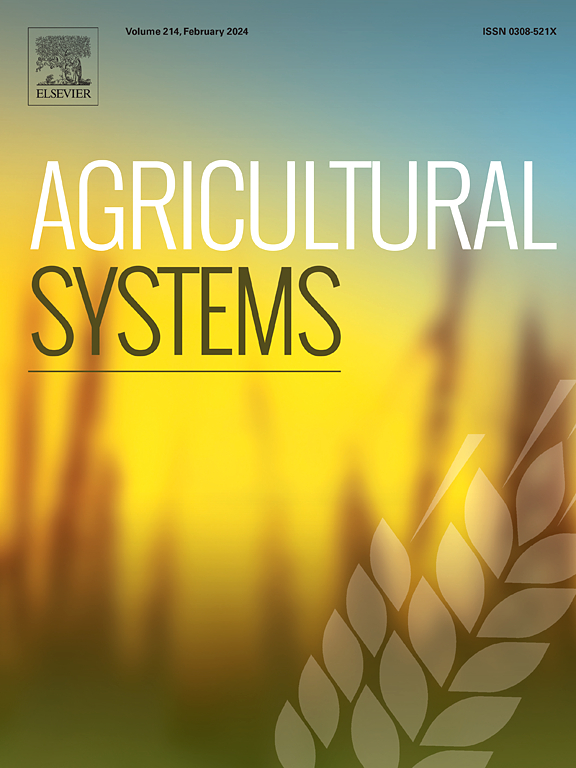Contribution of large-scale irrigation systems to food security and economic security: Evidence from the Bagré irrigation scheme in Burkina Faso
IF 6.1
1区 农林科学
Q1 AGRICULTURE, MULTIDISCIPLINARY
引用次数: 0
Abstract
CONTEXT
In the context of global change, large irrigation schemes are once again at the forefront of regional and national development plans. The Bagré irrigation scheme in Burkina Faso, with 16,780 ha planned, of which 3380 ha already under cultivation, is emblematic of this renewed interest. However, it is worth remembering that large irrigation schemes in sub-Saharan Africa have rarely delivered the expected benefits in terms of poverty alleviation and food sovereignty. A detailed analysis of the mechanisms at work can inform decision-makers about the risks of failure and how to prevent them.
OBJECTIVE
Understand why, despite the near quadrupling of cereal yields in the Bagré irrigation scheme compared with the rainfed area around, there has been no progress in poverty reduction and food sovereignty.
METHODS
To assess the contribution of this irrigation scheme to food and economic security, we compared the situation of 180 households on and off the scheme using a holistic approach. In-depth statistical analyses at the household level were combined with participatory analyses, using focus group discussions, the co-construction of food and economic security thresholds, and informal interviews. This helps to identify the underlying causes of the poor performance of this scheme and to discuss with stakeholders on solutions for enhancing their livelihoods.
RESULTS AND CONCLUSIONS
84 % of households in the irrigation scheme suffer from economic insecurity and 38 % from weak food security. Their situation is worse than that of households located outside the scheme (64 % and 25 %, respectively). This is mainly attributed to low access to off-farm opportunities and to irrigated land per worker: 0.30 ha, whereas at least 0.50 ha (or access to off-farm jobs) is needed to meet the needs of a worker and a dependent relative. If the high cost of land development (€15,000/ha) explains the allocation of small plots, the economic rationale for spending much money to keep people in poverty and in a more vulnerable situation than before is questionable. Environmental degradation is also significant (soil degradation, river pollution, and destruction of wildlife habitats).
SIGNIFICANCE
This study contributes to the debate on the ability of large irrigation schemes to reduce poverty and increase cereal production. This is an important issue, as there is renewed interest in these schemes following the 2008 food crisis. In Burkina Faso, large irrigation projects remain a priority, and the Bagré irrigation scheme is undergoing expansion, without a larger land area allocated to beneficiary households.

大规模灌溉系统对粮食安全和经济安全的贡献:来自布基纳法索bagr灌溉计划的证据
在全球变化的背景下,大型灌溉计划再次成为区域和国家发展计划的重点。布基纳法索的bagr灌溉计划规划了16780公顷的土地,其中3380公顷已经在耕种,这标志着这种重新燃起的兴趣。然而,值得记住的是,撒哈拉以南非洲的大型灌溉计划很少在减轻贫困和粮食主权方面带来预期的好处。对工作机制的详细分析可以使决策者了解失败的风险以及如何预防这些风险。目的:了解为什么尽管bagr灌溉计划的谷物产量与周围的雨育地区相比几乎翻了两番,但在减贫和粮食主权方面没有取得进展。方法为了评估该灌溉计划对粮食和经济安全的贡献,我们使用整体方法比较了180户家庭在计划实施和退出计划的情况。家庭层面的深度统计分析与参与性分析相结合,采用焦点小组讨论、粮食和经济安全阈值的共同构建以及非正式访谈。这有助于确定该计划表现不佳的根本原因,并与利益攸关方讨论改善其生计的解决方案。结果与结论该灌区84%的家庭存在经济不安全状况,38%的家庭存在粮食不安全状况。他们的情况比计划外的家庭更糟(分别为64%和25%)。这主要是由于每个工人获得非农机会和灌溉土地的机会少:0.30公顷,而满足工人和受抚养亲属的需要至少需要0.50公顷(或获得非农工作)。如果土地开发的高成本(每公顷1.5万欧元)解释了小块土地的分配,那么花费大量资金让人们处于贫困和比以前更脆弱的境地的经济理由是值得怀疑的。环境退化也很严重(土壤退化、河流污染和野生动物栖息地的破坏)。本研究有助于对大型灌溉计划减少贫困和增加谷物产量能力的争论。这是一个重要的问题,因为在2008年粮食危机之后,人们对这些计划重新产生了兴趣。在布基纳法索,大型灌溉项目仍然是一个优先事项,bagr灌溉计划正在扩大,但没有给受益家庭分配更大的土地面积。
本文章由计算机程序翻译,如有差异,请以英文原文为准。
求助全文
约1分钟内获得全文
求助全文
来源期刊

Agricultural Systems
农林科学-农业综合
CiteScore
13.30
自引率
7.60%
发文量
174
审稿时长
30 days
期刊介绍:
Agricultural Systems is an international journal that deals with interactions - among the components of agricultural systems, among hierarchical levels of agricultural systems, between agricultural and other land use systems, and between agricultural systems and their natural, social and economic environments.
The scope includes the development and application of systems analysis methodologies in the following areas:
Systems approaches in the sustainable intensification of agriculture; pathways for sustainable intensification; crop-livestock integration; farm-level resource allocation; quantification of benefits and trade-offs at farm to landscape levels; integrative, participatory and dynamic modelling approaches for qualitative and quantitative assessments of agricultural systems and decision making;
The interactions between agricultural and non-agricultural landscapes; the multiple services of agricultural systems; food security and the environment;
Global change and adaptation science; transformational adaptations as driven by changes in climate, policy, values and attitudes influencing the design of farming systems;
Development and application of farming systems design tools and methods for impact, scenario and case study analysis; managing the complexities of dynamic agricultural systems; innovation systems and multi stakeholder arrangements that support or promote change and (or) inform policy decisions.
 求助内容:
求助内容: 应助结果提醒方式:
应助结果提醒方式:


